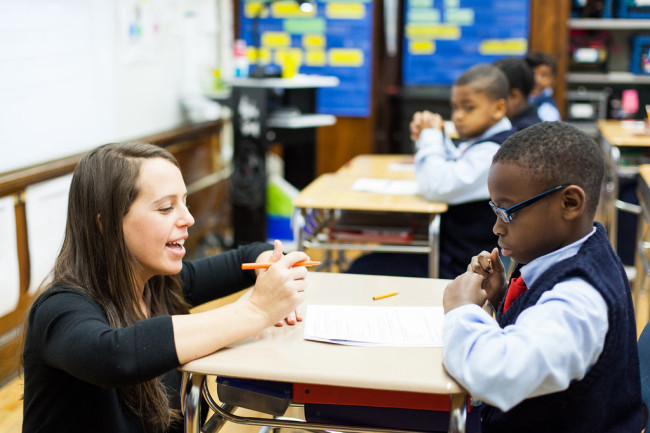05.13.15Sari Fromson Builds Productive, Positive Classroom Routines (Video)

Sari Fromson and one of her scholars
We had our weekly video meeting at TLaC towers today. The highlight was an amazing pair of clips that Joaquin Hernandez cut and edited of Sari Fromson, a 5th grade math teacher at Boston’s Roxbury Prep.
The first clip was shot this spring and shows beautiful and autonomous Systems and Routines in Sari’s classroom. As the clip opens her students are doing independent work, industriously solving a problem on their own. There is music playing. Everyone is working. Sari is looking over a student’s shoulder while reading her work. “Awesome job,” she says, and walks towards the front of the room. “When the music goes off, you know what to do,” she reminds her students gently. A few seconds later, while at the front of the room, Sari cuts the music. Her students stop their work and look at her. “What do we think?” she asks, smiling at the room. Hands go up, and the class is attentive, ready to discuss the problem as she calls on a scholar to share her work.
It’s a beautiful clip: warm and positive; orderly but in an unobtrusive way; incredibly efficient despite the gentle music. It is, in short, an almost perfect Systems and Routines clip. Students know exactly how to do their independent work. Her transition from that work to discussion takes a fraction of a second, and every student is attentive, ready to answer. Time is honored, diligence is universal, and it takes no effort from Sari at all. She has Transferred Ownership of the process to students, as her phrase “You know what to do,” intimates. (I discuss Transfer Ownership more on page 368 of Teach Like a Champion 2.0). All Sari has to do is turn off the music, and everything falls perfectly into place.
The second clip was shot this past fall, and while it perhaps may seem slightly less compelling, at first, in the end it is probably more telling. It shows how you build a classroom like Sari’s.
Again, music is playing as she circulates and gives feedback to students during independent work, but this time Sari stops the music first and says, “Twenty seconds left” to prepare students for the transition. She then provides a second reminder right before the timer goes off: “When the timer goes off you know what to do. Anthony is already there.” At the beep of the timer, she gives yet another brief reminder: “alright let me see it!” Then another: “Hands are folded. You’re tracking me. Like Jamal; Kenny is there. Nice job, boys…” She’s positive—her reminders are textbook Positive Framing–but persistent. Then as she begins teaching there are two Self-Interrupts (see page 415 in Teach Like a Champion 2.0 on the Self-Interrupt). She is building expectations.
This is fascinating in two ways. We can see how the routine from the fall previews the final routine but includes greater structure—she steps in more persistently to make sure they know expectations and meet them—and how over time, with success, she eliminated parts of the procedure to simplify it and give students more ownership- the timer was replaced by the music; reminders disappeared; the students came to own the routine.
But we can also see here the work that goes into building a system that is autonomous and how different the end point of an established system feels from the task of building it. Only when you’ve seen the clip from the spring does the clip shot in the fall fully make sense. Without it, you might not understand the “why” behind Sari’s moves. Why does she have to be so persistent? Why so much structure? You might be put off by it. Or think: “My gosh, I don’t have the stamina to do that forever and ever.” But Sari shows us that in this moment she is passing through the eye of the needle. The structure builds the warm, happy, seamless autonomy.
She also shows us something else: that, in short, personality is technique. This is a topic I’ve been reflecting on since watching a video of one of our Deans of Students which I hope to share soon– who doesn’t aspire to be the teacher who plays soft music; who smiles warmly at her class and benignly observes them all working happily and industriously away? So why don’t all classes look that way? No one, after all, takes the job because they aspire to be stressed out, frazzled, and yelling at kids. The answer, I think, is technique. That mastery of skill allows us to become the teacher we want to be. More on that in a future blog post. For now, enjoy this clip from Sari’s class.
